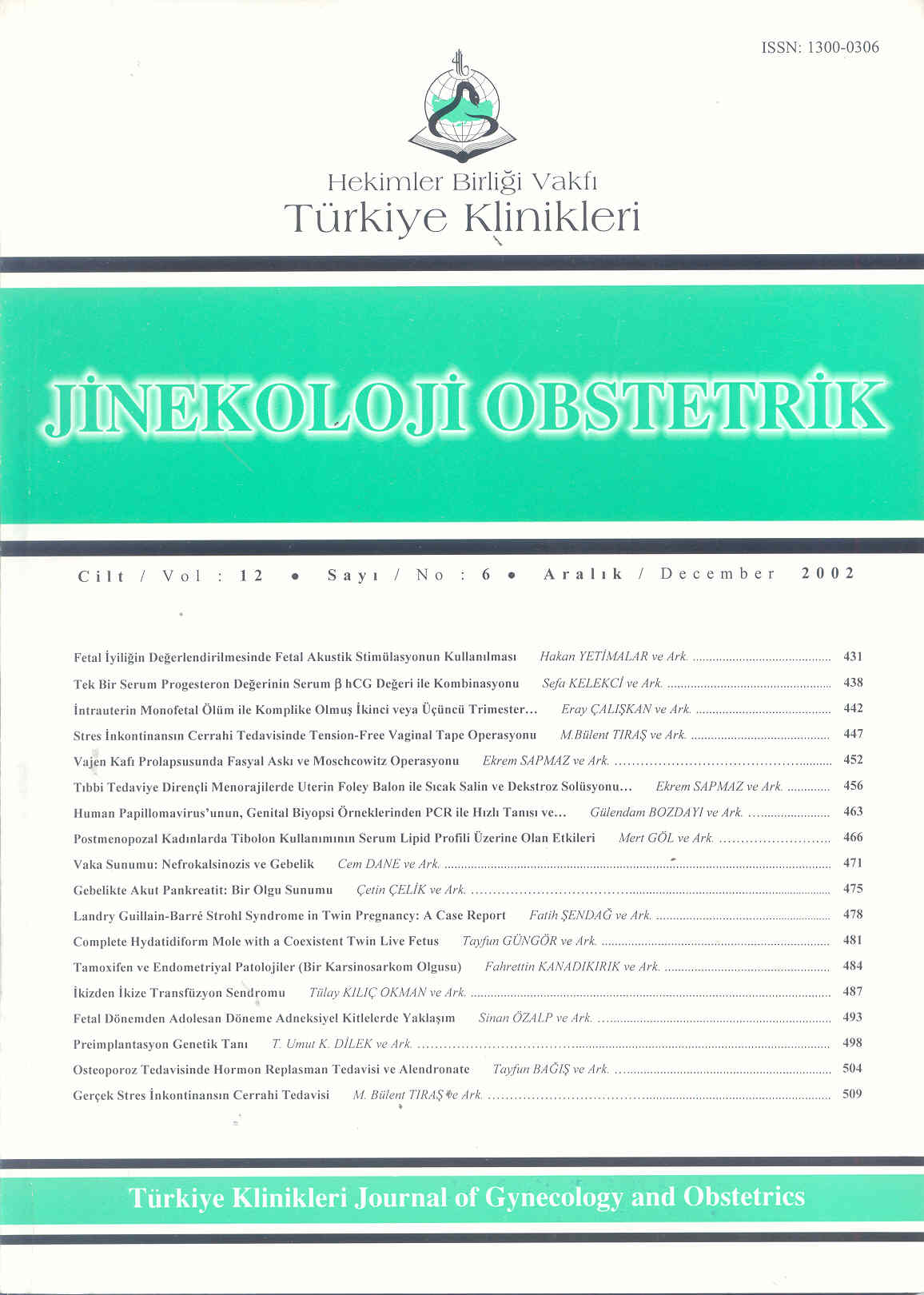Open Access
Peer Reviewed
ARTICLES
3047 Viewed974 Downloaded
The Effects Of Tibolone On Serum Lipid Profile In Postmenopausal Obese And Non- Obese Women
Obez ve Non-Obez Postmenopozal KadınlardaTibolon Kullanımının Serum Lipid Profili Üzerine OlanEtkilerinin Karşılaştırılması
Turkiye Klinikleri J Gynecol Obst. 2002;12(6):466-70
Article Language: TR
Copyright Ⓒ 2025 by Türkiye Klinikleri. This is an open access article under the CC BY-NC-ND license (http://creativecommons.org/licenses/by-nc-nd/4.0/)
ÖZET
Amaç: Non-obez ve obez postmenopozal dönemdeki kadınlarda tibolone kullanımının, serum lipid profili üzerine olan etkilerinin karşılaştırılması.Çalışmanın Yapıldığı yer: Ege Üniversitesi Tıp Fakültesi Kadın Hastalıkları ve Doğum A.B.D.Materyal ? Metod: Postmenopozal dönemdeki sağlıklı 20 hasta çalışmaya alındı. Hastalar vücut kitle indeks (VKİ) değerlerine göre Grup-1 şişman obez olmayan (VKİ<30 kg/m2) ve Grup-2 şişman olanlar (VKİ >30 kg/m2) olarak iki gruba ayrıldı. Olgulara 6 ay boyunca 2.5 mg tibolone tedavisi verildi. Her iki grupta tedavi öncesi, tedavinin 3. ayında ve tedavi sonrasında serum Total-Kolesterol, Trigliserit, Yüksek Dansiteli Lipoprotein (HDL), Düşük Dansiteli Lipoprotein (LDL) ve Apoliporotein A1 (Apo A1) değerleri ölçülerek karşılaştırıldı.Bulgular: Grup-1 de tedavi boyunca ve tedavinin sonunda serum Total-Kolesterol, Trigliserit ve LDL düzeylerinde istatiksel olarak anlamsız bir azalma saptanırken (p>0.05), HDL ve Apo A1 serum düzeylerinde istatiksel olarak anlamsız bir artış saptandı (p>0.05). Grup-2 de tedavi boyunca ve tedavinin sonunda serum total-kolesterol, trigliserit ve LDL düzeylerinde istatiksel olarak anlamsız bir azalma saptanırken (p>0.05), yine serum HDL seviyelerinde de istatiksel olarak anlamsız bir azalma saptandı. Özellikle Grup-2 de Apo A1 düzeylerinde tedavi sonunda istatiksel olarak anlamlı bir azalma saptandı (p<0.05).Sonuç: Tibolon tedavisi postmenopozal obez hastalardaki serum lipid profilini non-obez hastalardan farklı olarak daha olumsuz etkiliyebilmektedir. Özellikle grup ? 2 olgularda Apo A1 düzeyleri olumsuz etkilenmekte, buda ateroskleroz ve koroner kalp hastalığı açısından bir risk faktörü oluşturmaktadır.
Amaç: Non-obez ve obez postmenopozal dönemdeki kadınlarda tibolone kullanımının, serum lipid profili üzerine olan etkilerinin karşılaştırılması.Çalışmanın Yapıldığı yer: Ege Üniversitesi Tıp Fakültesi Kadın Hastalıkları ve Doğum A.B.D.Materyal ? Metod: Postmenopozal dönemdeki sağlıklı 20 hasta çalışmaya alındı. Hastalar vücut kitle indeks (VKİ) değerlerine göre Grup-1 şişman obez olmayan (VKİ<30 kg/m2) ve Grup-2 şişman olanlar (VKİ >30 kg/m2) olarak iki gruba ayrıldı. Olgulara 6 ay boyunca 2.5 mg tibolone tedavisi verildi. Her iki grupta tedavi öncesi, tedavinin 3. ayında ve tedavi sonrasında serum Total-Kolesterol, Trigliserit, Yüksek Dansiteli Lipoprotein (HDL), Düşük Dansiteli Lipoprotein (LDL) ve Apoliporotein A1 (Apo A1) değerleri ölçülerek karşılaştırıldı.Bulgular: Grup-1 de tedavi boyunca ve tedavinin sonunda serum Total-Kolesterol, Trigliserit ve LDL düzeylerinde istatiksel olarak anlamsız bir azalma saptanırken (p>0.05), HDL ve Apo A1 serum düzeylerinde istatiksel olarak anlamsız bir artış saptandı (p>0.05). Grup-2 de tedavi boyunca ve tedavinin sonunda serum total-kolesterol, trigliserit ve LDL düzeylerinde istatiksel olarak anlamsız bir azalma saptanırken (p>0.05), yine serum HDL seviyelerinde de istatiksel olarak anlamsız bir azalma saptandı. Özellikle Grup-2 de Apo A1 düzeylerinde tedavi sonunda istatiksel olarak anlamlı bir azalma saptandı (p<0.05).Sonuç: Tibolon tedavisi postmenopozal obez hastalardaki serum lipid profilini non-obez hastalardan farklı olarak daha olumsuz etkiliyebilmektedir. Özellikle grup ? 2 olgularda Apo A1 düzeyleri olumsuz etkilenmekte, buda ateroskleroz ve koroner kalp hastalığı açısından bir risk faktörü oluşturmaktadır.
ANAHTAR KELİMELER: Tibolon, Serum lipid profili, Vücut kitle indeksi
ABSTRACT
Objective: The effects of tibolone on serum lipid profile in obese and non-obese postmenopausal women.Institution: Ege University Faculty of Medicine Department of Obstetrics and Gynecology.Materials and Methods: Twenty healty postmenopausal women were recruited into the study. According to their body mass indexes patients were divided into 2 groups, Group-1 non-obese (BMI<30kg/m²) and Group-2 obese (BMI>30kg/m² ) which containing 10 patients in each group. Tibolone 2.5 mg was given for six months. Serum total-cholesterol, tryglyseride, high density lipoprotein (HDL), low density lipoprotein (LDL) and Apolipoprotein A1 (Apo A1) levels were measured and compared in both of the groups, before, at the 3rd month and at the end of the therapy. Results: Serum total-cholesterol, tryglyseride, LDL levels decreased insignificantly (p>0.05) in Group-1 during and at the end of the treatment, but serum HDL and Apo A1 levels increased insignificantly (p>0.05) during and at the end of the treatment. In Group-2, serum total-cholesterol, tryglyseride, LDL levels decreased insignificantly (p>0.05) during and at the end of the treatment, but serum HDL levels decreased in contrast with Group-1. Especially, Apo A1 levels decreased significantly (p<0.05) in Group-2 at the end of the threapy.Conclusion: Tibolone treatment may have negative effects on serum lipid profile in obese postmenopausal patients in comparison with non-obese patients. Especially Apo A1 levels have been effected negative in group -2 cases, and this constitutes a risk factor for atherosclerosis and coronary heart diseases.
Objective: The effects of tibolone on serum lipid profile in obese and non-obese postmenopausal women.Institution: Ege University Faculty of Medicine Department of Obstetrics and Gynecology.Materials and Methods: Twenty healty postmenopausal women were recruited into the study. According to their body mass indexes patients were divided into 2 groups, Group-1 non-obese (BMI<30kg/m²) and Group-2 obese (BMI>30kg/m² ) which containing 10 patients in each group. Tibolone 2.5 mg was given for six months. Serum total-cholesterol, tryglyseride, high density lipoprotein (HDL), low density lipoprotein (LDL) and Apolipoprotein A1 (Apo A1) levels were measured and compared in both of the groups, before, at the 3rd month and at the end of the therapy. Results: Serum total-cholesterol, tryglyseride, LDL levels decreased insignificantly (p>0.05) in Group-1 during and at the end of the treatment, but serum HDL and Apo A1 levels increased insignificantly (p>0.05) during and at the end of the treatment. In Group-2, serum total-cholesterol, tryglyseride, LDL levels decreased insignificantly (p>0.05) during and at the end of the treatment, but serum HDL levels decreased in contrast with Group-1. Especially, Apo A1 levels decreased significantly (p<0.05) in Group-2 at the end of the threapy.Conclusion: Tibolone treatment may have negative effects on serum lipid profile in obese postmenopausal patients in comparison with non-obese patients. Especially Apo A1 levels have been effected negative in group -2 cases, and this constitutes a risk factor for atherosclerosis and coronary heart diseases.
MENU
POPULAR ARTICLES
MOST DOWNLOADED ARTICLES





This journal is licensed under a Creative Commons Attribution-NonCommercial-NoDerivatives 4.0 International License.










